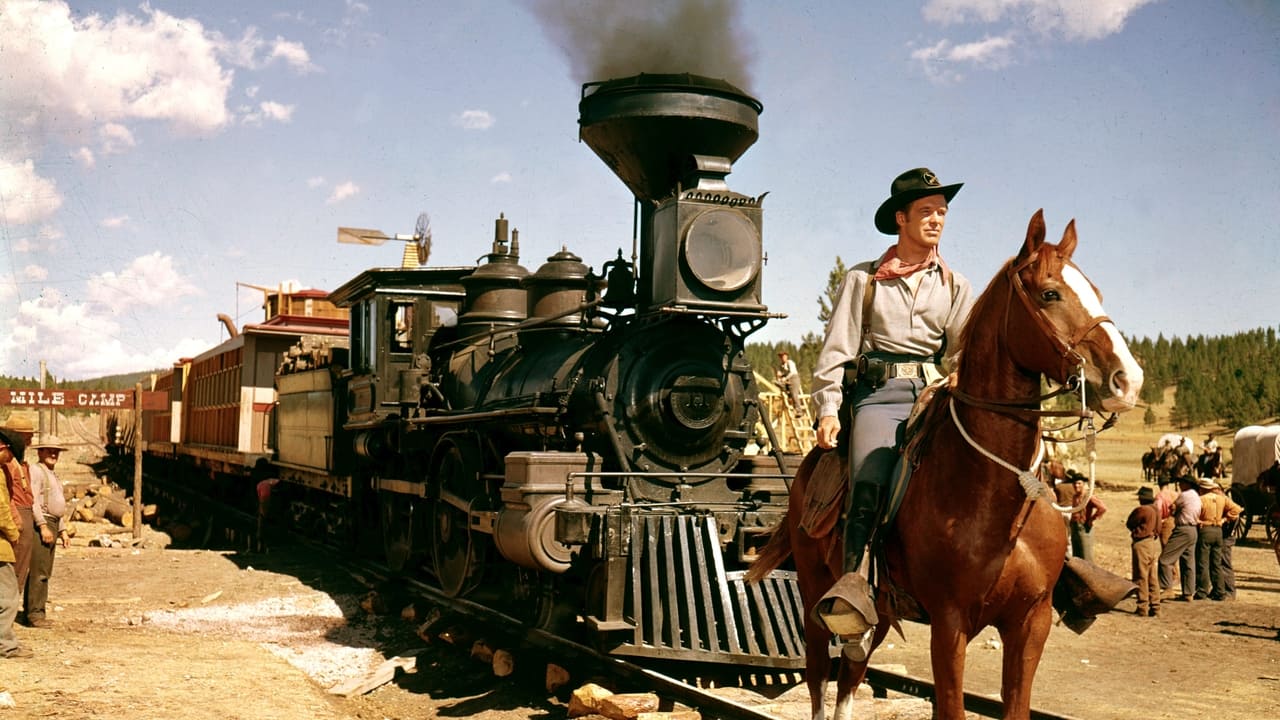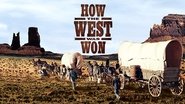bbmtwist
HOW THE WEST WAS WON was the 8th and final Cinerama film. Six travelogues preceded it, as well as MGM's only other feature in the process, THE WONDERFUL WORLD OF THE BROTHERS GRIMM (1962), released the year prior.MGM had taken a chance on the process to be able to satisfy the widescreen and stereophonic craze for epic films, but abandoned it due to its unsatisfactory performance next to its rival, Ultra Panavision 70, in which MGM produced MUTINY ON THE BOUNTY, also in 1962. The use of one camera, one strip of film and no curvature, and the ability to bring back close ups and medium shots sealed Cinerama's fate.This was a grand way to go out though. Five periods of the taming of the West: The River, The Plains, The Civil War, The Railroad, and The Law, and a roster of stars (13 leading, 10 supporting, plus a narrator). It had everything; story, cohesion, thrills – and all in enormous curved screen and Technicolor glory. At two hours and 44 minutes, it was the longest of the 8 Cinerama films and with its final shots (taken from or re-taken as a tribute to the America The Beautiful sequence ending THIS IS CINERAMA (the initial film in the process), it brought the Cinerama story full circle.Sad though that Cinerma cameras had a tendency to be covered with splotches of dirt in its aerial shots. This is rampant throughout the travelogues and here we can see it during Spencer Tracy's initial narration and at the end montage. How digital clean-up for Smilebox DVD presentation could have ignored these obvious defects is beyond my imagination.The image still needs some color correction and the images need sharpening, but the Smilebox DVD release is the best we have so far. The superlative score by Alfred Newman (one of his very best) is in turns stirring and sentimentally moving. Probably the most wrenching scene is Zeb's departure for the war, in which direction, score and the subdued performances of Carroll Baker and George Peppard bring tears.It is recommended to every lover of western films and to those in love with wide screen photography. The locations are gorgeous and always there to look at if one gets bored with the acting, direction or story line. All the actors do a creditable job, with the exception of Debbie Reynold's "old Lilith" at the end of the film. She did go on the next year to earn her only Oscar nom – for THE UNSINKABLE MOLLY BROWN (which used the same mansion exterior as her San Francisco house in WEST, by the way).It is interesting also to note upon reading these almost 150 reviews on the IMDb pages, that there seems to be no middle ground. Either reviewers loved the film or hated it. It's up to you to decide for yourself, but you must not miss it.
tomgillespie2002
Very much like IMAX's grandiose stand against the emergence of internet streaming, Blu-Ray and the 'Golden Age of Television', the 1950's saw studios battling against the arrival of a television in every home, and used the likes of 3D and 'Spook Show Spectaculars' to draw the public in. Another short-lived fad was Cinerama, a process of shooting with three synchronised cameras and creating an ultra widescreen effect in the process. It was a headache for film- makers, notably John Ford, and special cinemas had to be built to house the format that required three projectors and a deeply curved screen.Also like IMAX, Cinerama was intended mainly for documentaries, but its immediate success meant that it wouldn't be too long before studios started to turn to features. The first was The Wonderful World of the Brothers Grimm in 1962, and How the West Was Won came later the same year. The latter is the most ambitious, telling a story stretching 50 years across three generations and boasting a cast of '24 great stars' (as the poster informs us), taking us through the major events of America's expansion further west and employing four first-rate directors - John Ford, Henry Hathaway, George Marshall and the uncredited Richard Thorpe - to bring it to life.Whilst the ambition can only be admired, How the West Was Won is a mixed bag. In part a rough-and-tumble, old-fashioned western that offers differing perspectives of America's venture out west, as Henry Fonda's grizzled buffalo hunter Jethro Stuart laments the bloody consequences of the railroad's arrival under the command of Richard Widmark's ruthless and treaty-dismissing overseer, the film also cannot resist the lure of grand song-and-dance numbers, with Debbie Reynolds husky voice and knee-slapping becoming tiresome very quickly. It also keeps the audience at a huge distance, both emotionally and literally. With so much picture being captured, actors are routinely squeezed into the centre of the frame with their facial expressions too far away to see.Broken up into 5 segments - The Rivers, The Plains, The Civil War, The Railroad and The Outlaws - we follow the Prescott family, led at first by Zebulon (Karl Malden), as they head for the frontier and encounter mountain man Linus Rawlings (a woefully miscast James Stewart). Rawlings falls for eldest daughter Eve (Carroll Baker), and the family spread out from there. Hathaway directs three of the five, with the best being the Outlaws section, which pits George Peppard's Zeb Rawlings. a marshal, against bandit Charlie Gant (Eli Wallach), and delivers a set-piece on top of moving train which is as technically impressive as anything made today (a stunt-man almost died during the filming).Ford's Civil War segment is the slightest but offers an interesting insight into the war. In one fantastic scene, General Ulysses S. Grant (Harry Morgan) drunkly ponders his effectiveness to General William Sherman (John Wayne) as the young Zeb Rawlings listens, demonstrating Ford's lack of fear in showing a brittler side to a man considered an unshakeable American hero. But Ford and the film in general never really commits to the themes it hints at, and this is ultimately what makes How the West Was Won such a frustrating experience. As the camera sails across modern America before the closing credits, I felt slightly appalled at what had been done to this once-beautiful country but couldn't really figure out if this was how the film intended I feel. As a visual experience, it is truly like no other, but it remains oddly hollow emotionally and thematically.
Neil Welch
An overview of the colonisation of the central and western USA is told via various episodic tales of the trials and triumphs of several generations of one family.This 1962 movie was an Event as much as a film. It ran for nearly 3 hours, it featured a large number of big stars in roles from major down to cameos, and it was a Cinerama presentation - 3 linked cameras filmed 3 linked images which were projected on 3 linked screens which ran in a near semicircle, engaging the audience's peripheral vision.And that, in a nutshell, is both the film's greatest strength and its greatest weakness. For the very nature of Cinerama mean that the film is necessarily composed throughout in wide angle shots, many of which are simply gorgeous landscape vistas or shots of spectacular action. Conversely, given the choice to tell the story through one family, it turns out to be very difficult to convey intimacy when you can't use closeups. There are further problems, especially with sideways camera movements or lateral action - the fact that the left and right thirds of the image were at an angle to the audience plays tricks on a flat screen.It is nice to report that good work has been done on the remaster: the vertical lines where the 3 images met have been largely rendered unnoticeable where, previously, they were quite jarring on a TV screen.As for the film itself, putting to one side image issues (good and bad) and the starry cast list - well, it's OK. It tells a big story in general terms, and tells it tolerably well (but not brilliantly). Definitely well worth a watch, though.
gavin6942
A family saga covering several decades of Westward expansion in the nineteenth century -- including the Gold Rush, the Civil War, and the building of the railroads.This may be the western for those who do not like westerns. Although I could have done without the overture and intermission (which would cut off ten minutes), the rest is excellent and has more big name stars than can be counted on two hands. For those who love westerns, we have John Wayne (and Lee Van Cleef), and for everyone else we have Jimmy Stewart, Gregory Peck and more...I loved the historical nature of this. It was sort of like the old west version of "Centennial". And the connection to modern Los Angeles was a tad hokey, but at the same time had a good bit of truth to it... a mere 100 years before this film was made, Hollywood was wilderness.



 AD
AD





